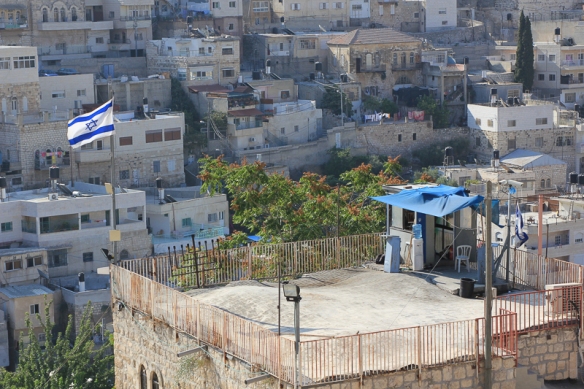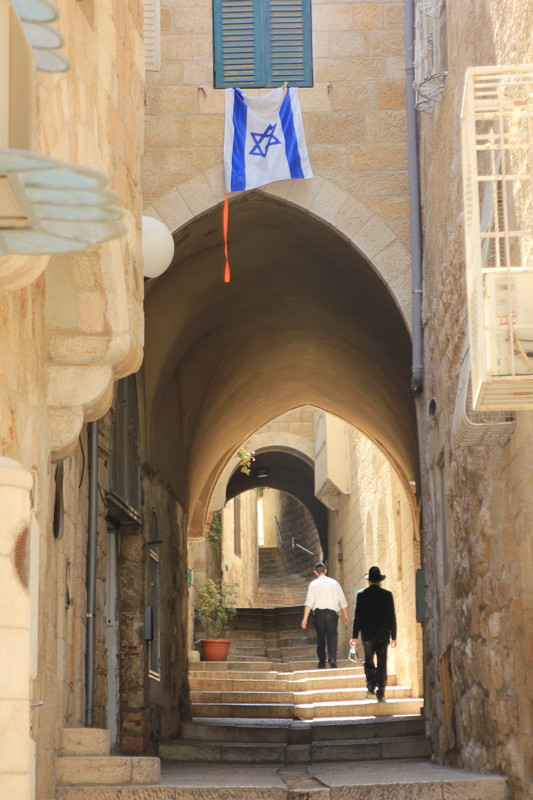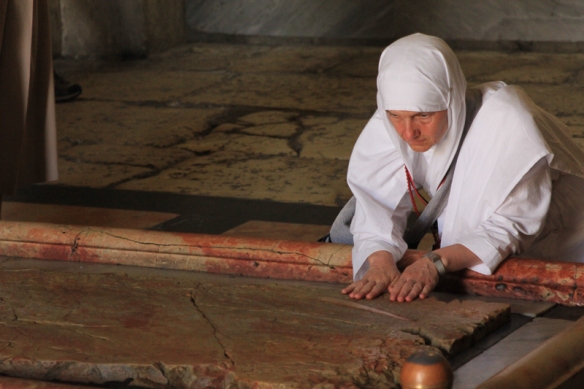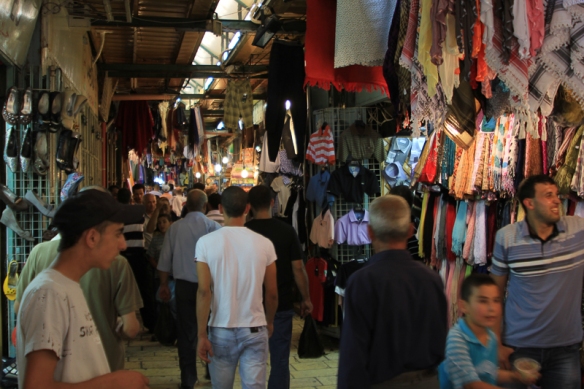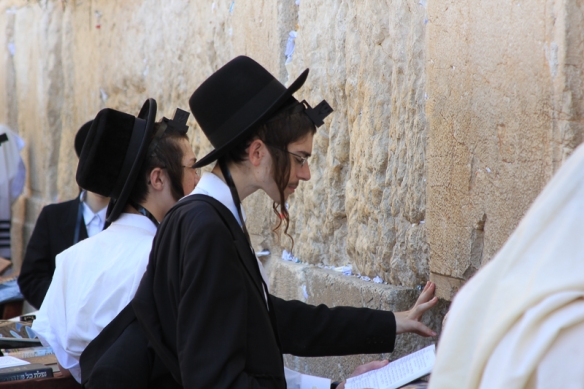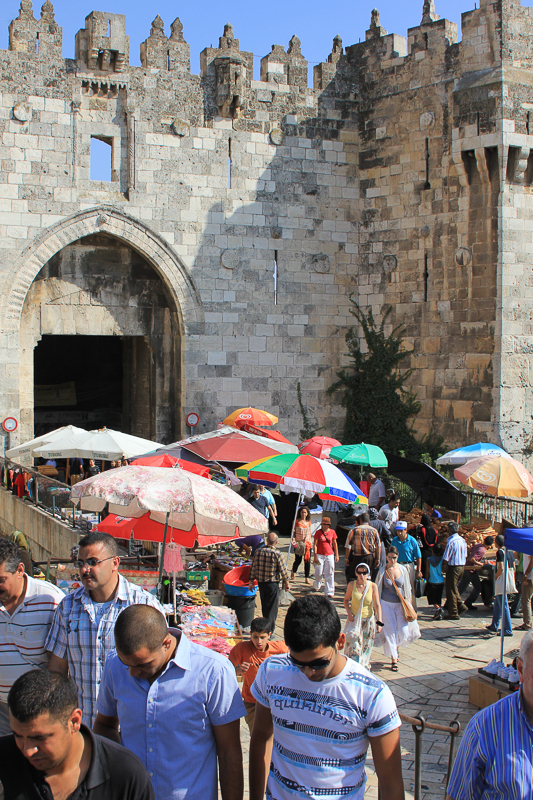Jerusalem is nothing like Tel Aviv and it’s far more interesting for it.
This past Friday was the first one of Ramadan, and the Israeli’s expected trouble. I awoke just before six, by which time thousands of additional police and Para-military were already setting up checkpoints and roadblocks in an effort to control access into the old city. The first group took up position outside the walls, re-directing traffic and blocking off many of the streets that lead to the old city’s main gates. Passing through East Jerusalem, my driver was able to get me to the City of David, which is just south of Dung gate, outside the present walls and the only entrance directly onto the Wailing Wall. Today, it’s one of only two into the Jewish Quarter itself. Jerusalem has a wildly complex history, and without a good set of maps it’s almost impossible to figure out the different bits that were, are, or might be, part of the old city. Briefly, much of what is today within the walls, was just goat pastures when a rather self-assured young carpenter started telling people to stop hitting each other with sticks and worship him instead.
Even though now outside the walls, The City of David is the oldest part of Jerusalem and holds a strong allure for Israelis. If there was a King David, this is likely where he lived. (The jury is out on that one though. Other than the Bible, there’s scant reference to David. A single Aramaean fragment might say “House of David”, but is also might say “House of Kettle.” The City of Kettles, doesn’t have the same ring to it.) The most impressive feature is Hezekiah’s tunnel which cuts through bedrock to provide an underground, and hence secure, channel for water to flow into the city. The Hong Kong tour group in front of me was all giggles. Having arrived before it opened, and I tend to migrate away from the most heavily trafficked areas, I decided to head down the hill, and out into the streets below. As it turns out, I was at the edge of Silwan, a Palestinian village, and now a trouble spot as Jewish settlers push in. The settlers use a variety of methods to buy up, or have demolished, Palestinian houses, and then take the land. The differences are stark as you begin to notice clusters of houses with Jewish flags, better maintained exteriors, and armed guards. As I explored, a local settler passed me, dressed in traditional black, carrying a shopping bag, and with a pistol shoved into the back of his pants. It’s remarkable to me that some would choose to live this way. So although things were calm while I was there, there was plenty of evidence of the potential for violence.
At the end of one street, where a row of Jewish houses thrust deeper into Silwan, I noticed a Jewish security guard up the hill watching me intently…or at least I had thought it was me he was watching. A few minutes later a small blue bus pulled up below me, and a rather stern security guard from the bus jumped out and took up position. Khaki pants, polo-shirt, equipment vest, and just generally far too many pockets. A Jewish boy, perhaps twelve, emerged from up the street and hurried down to the awaiting vehicle. He said something to the guard while pointing towards the Palestinian area. The guard did not reply, his eyes never leaving the Palestinian street as he simply nudge the boy into the bus. With the boy safety aboard, the bus backed-up, and drove off to a day of recess and pulling girls’ hair. We had guards on our busses where I grew up as well, but they were local military recruits, and I doubt gave a hoot what happened to us.
Walking back up the hill into the Jewish area, I noticed for the first time two different lookouts built atop buildings. The first was manned and keeping a careful eye on the Palestinian buildings just across a small dry stream bed. The second looked like it had been thrown together in haste, perhaps during the last Intifada. Nice life, huh?
The second group of extra police positioned themselves near the Wailing Wall. There is a large, modern ramp the runs up on one side of the Western Wall and ends at a small gate that opens onto the Temple Mount itself. Muslim’s don’t enter that way, and would certain not use it to leave, which leaves its purpose open to speculation, but the evidence points to security. It’s covered, so you can’t see what goes on in there, but I happened to catch a glimpse of a platoon of heavily armed police snaking their way up to take position just behind a gate at the top. In case the prayer services ends in something of a riot, I figure, its looks like they’re ready to spill onto the Temple Mount and take control.
Jerusalem is broken out into four distinct quarters, though the distinction blurs a fair bit at the seams. The Jewish Quarter, substantially destroyed in ’48 after the British washed their hands of the entire place, was extensively rebuilt and repopulated after the six-day war in ’67. It’s clean, orderly, and generally where tourists go to buy Gelato and not worry that they’re wearing a Cheney for President t-shirt. A great deal of archeology has been done in this section, revealing numerous ruins, all destroyed during the Roman sacking of the city in 70 A.D., the event which arguably birthed the main problem the Middle East is still dealing with today. The fires which roared through the city left soot and scorch marks on floor mosaics which you can still see today. In one home they found a spear and severed arm, and next to those, charred wooden beams from the ceiling.
The Christian and Muslim quarters are similar to one another, but you find more tourists venturing into the Christians areas. Both quarters are a maze of congested alleys jammed with all manner of tiny shops hawking their goods. Very little natural light makes it in. The main alleys are illuminated by exposed blubs hanging from makeshift wires strung above. As you head deeper into the Muslim area, the tourist trinkets give way to shops full of spices, skinned goats, and women’s underwear. It’s here that a better part of East Jerusalem does its shopping. You also soon notice that unlike in the Christian areas, the number of tourists has dropped off substantially, and native speakers of English are almost extinct. It’s left to a few intrepid Europeans to venture this deep. The area is poorly kept, and the smaller alleys which lead away from the main thoroughfares are less than welcoming. Unlike the Jewish Quarter with its signs reminding people that you’re walking through a family neighborhood, so please be respectful, here packs of local kids seem to live a Lord of the Flies like existence, like something from a grade school teacher’s nightmare. In one alley I found a group charging about with flaming torches, laughing as they spun the torches wildly, letting the embers fly off and burn their friends. Kids and their games. The Armenian Quarter is the smallest of the four, and really just amounts to a few anti-Turkish posters up on a wall.
What seems like the largest contingent of police took up position in these alleys, particularly the ones leading to Al Aqsa mosque, but unlike our riot police who stand in long rigid lines with visors down, these leaned up against walls, chatted, and generally looked as though they didn’t have a care in the world. No doubt the moment something went wrong they would have gotten to the business of violating human rights, but for now it went a long way to keeping the atmosphere from being explosive. Unfortunately, as a result of their presence I couldn’t get very close to the Temple Mount. As I tried to follow the worshipers, an officer stopped me, and pointed me to a different route, one leading away. To keep a lid on tensions, even the area leading to the Temple Mount was bared to non-Muslims, and apparently I stood out as one of those. Must have been my shoes. Later in the day, after prayers were over, a reverse flow began as the city once again emptied of Muslim worshippers. It is like watching the tide,a hungry tied waiting for the sun to set so they could feast.
There are a number of observational points in the Jewish quarter that look down at the Wailing Wall. These are typically well policed. There’s also a much bigger one right above on the Temple Mount itself, but rather than being observational, that one’s typically used for throwing stones at the Jews below. In the afternoon, as I was getting ready to head back to the hotel, I came across a young group of French Jews who were obviously making a pilgrimage to the city. They were at one of the observational points, carrying a large Israeli flag, and oddly two of their group were blindfolded. That sort of thing never bodes well in the Middle East, and typically ends up on a Jihadist version of YouTube, but the two police nearby didn’t seem terribly concerned, so I stood about and watched. Their guide went through a dramatic speech full of emotion and obviously designed to build excitement. As he neared the climax he held up a radio and played the voice of Mordechai Gur from ’67, announcing that his men had just taken the Temple Mount. It was all very theatrical and obviously designed to build a certain level of expectation. Then with a final flourish off came the blindfolds, and the students saw the wall for the first time. The first of the two turned, face blank, mouth slightly open. I’m not sure if it was a look of awe, disappointment, or excitement so far off the dial his facial muscles just gave up and sagged. They sang, they clapped, and they wandered off, perhaps to find the Gelato.
I bought a late lunch in the Muslim Quarter (Dates, bread, and an amazing form of baklava with a custard layer), then headed out through the Damascus gate on my way back to the hotel. Damascus Gate is chaos in motion, a collision of roads, people, and goods that can be heard for miles away. It’s easy to slip back in time there and I’d like to go back, perhaps this time with earplugs.
Just past the gate, and run by the most cordial British Protestants, is the Garden Tomb, which many believe to be the actual site of both the crucifixion and burial of Christ, rather than the Church of the Holy Sepulcher within the Christian Quarter. Although archeologists have mostly debunked this idea, in typical British fashion the volunteer guides point out that, “well, yes, that might be so, but wouldn’t it be ever so nice if it were true?” And then, with pleasant smile, “Did you know the garden has the 3rd largest cistern in Israel?” After a long day, it’s an ideal spot to find a little bench and sleep.
The expected violence never arrived, at least not this time. Local commentators point out that with the PA doing a reasonable job of maintaining order, jobs are the biggest issue in the West Bank now. Gaza, rockets, and pushing the Jews back into the sea will have to wait. As for the border with Lebanon, now that’s where there’s going to be another war, as early as later this summer, if the pundits are to be believed.
Saturday it’s the West Bank, Masada, and the Dead Sea. If I can float anywhere, that’s the spot.

